Evaluation of Neighborhood Socio-Economic Status, as Measured by the Delphi Method, on Dengue Fever Distribution in Jeddah City, Saudi Arabia
Abstract
1. Introduction
2. Materials and Methods
2.1. Study Area and Data Sources
2.2. Research Methods
2.3. Results
3. Results and Discussion
4. Conclusions
Author Contributions
Funding
Institutional Review Board Statement
Informed Consent Statement
Data Availability Statement
Conflicts of Interest
References
- Egger, J.; Ooi, E.; Kelly, D.W.; Woolhouse, M.E.; Davies, C.R.; Coleman, P.G. Reconstructing historical changes in the force of infection of dengue fever in Singapore: Implications for seillance and control. Bull. World Health Organ. 2008, 86, 187–196. [Google Scholar] [CrossRef] [PubMed]
- Guha-Sapir, D.; Schimmer, B. Dengue fever: New paradigms for a changing epidemiology. Emerg. Themes Epidemiol. 2005, 2. [Google Scholar] [CrossRef] [PubMed]
- WHO. Dengue Fact Sheet. Neglected Tropical Diseases. New Delhi. Available online: http://.www.searo.who.int/entity/vector_borne_tropical_diseases/data/data_factsheet/en/ (accessed on 2 April 2019).
- Bhatt, S.; Gething, P.W.; Brady, O.J.; Messina, J.P.; Farlow, A.W.; Moyes, C.L.; Drake, J.M.; Brownstein, J.S.; Hoen, A.G.; Sankoh, O. The global distribution and burden of dengue. Nat. Med. 2013, 496, 504–507. [Google Scholar] [CrossRef]
- WHO. Impact of Dengue. Available online: http://www.who.int/csr/disease/dengue/impact/en/ (accessed on 24 April 2015).
- Herricks, J.R.; Hotez, P.J.; Wanga, V.; Coffeng, L.E.; Haagsma, J.A.; Basáñez, M.-G.; Buckle, G.; Budke, C.M.; Carabin, H.; Fèvre, E.M.; et al. The global burden of disease study 2013: What does it mean for the NTDs? PLoS Negl. Trop. Dis. 2017, 11, e0005424. [Google Scholar] [CrossRef]
- Singh, M.P.; Chand, S.K.; Jaiswal, A.; Dhimanb, R.C. Trends of dengue fever in Madhya Pradesh, India. Dengue Bull. 2018, 40, 72. [Google Scholar]
- Antinori, S.; Galimberti, L.; Gianelli, E.; Calattini, S.; Piazza, M.; Morelli, P.; Moroni, M.; Galli, M.; Corbellino, M. Prospective observational study of fever in hospitalized returning travelers and migrants from tropical areas, 1997–2001. J. Travel Med. 2004, 11, 135–142. [Google Scholar] [CrossRef]
- WHO. Prevention and Control of Dengue and Dengue Haemorrhagic Fever: Comprehensive Guidelines; SEARO: New Delhi, India, 1999. [Google Scholar]
- Abdalmagid, M.; Alhusein, S.H. Entomological investigation of Aedes aegypti in Kassala and Elgadarief State, Sudan. Sudan. J. Public Health 2008, 3, 77–80. [Google Scholar]
- Otero, M.; Schweigmann, N.; Solari, H.G. A stochastic spatial dynamical model for Aedes aegypti. Bull. Math. Biol. 2008, 70, 1297–1325. [Google Scholar] [CrossRef]
- Carabali, M.; Harper, S.; Lima Neto, A.S.; Dos Santos de Sousa, G.; Caprara, A.; Restrepo, B.N.; Kaufman, J.S. Spatiotemporal distribution and socioeconomic disparities of dengue, chikungunya and Zika in two Latin American cities from 2007 to 2017. Trop. Med. Int. Health 2021, 26, 301–315. [Google Scholar] [CrossRef]
- Alhaeli, A.; Bahkali, S.; Ali, A.; Househ, M.S.; El-Metwally, A.A. The epidemiology of Dengue fever in Saudi Arabia: A systematic review. J. Infect. Public Health 2016, 9, 117–124. [Google Scholar] [CrossRef]
- Fakeeh, M.; Zaki, A.M. Virologic and serologic surveillance for dengue fever in Jeddah, Saudi Arabia, 1994–1999. Am. J. Trop. Med. Hyg. 2001, 65, 764–767. [Google Scholar] [CrossRef]
- Al-Azraqi, T.A.; El Mekki, A.A.; Mahfouz, A.A. Seroprevalence of dengue virus infection in Aseer and Jizan regions, Southwestern Saudi Arabia. Trans. R. Soc. Trop. Med. Hyg. 2013, 107, 368–371. [Google Scholar] [CrossRef] [PubMed]
- Ayyub, M.; Khazindar, A.M.; Lubbad, E.H.; Barlas, S.; Alfi, A.Y.; Al-Ukayli, S. Characteristics of dengue fever in a large public hospital, Jeddah, Saudi Arabia. J. Ayub Med. Coll. Abbottabad 2006, 18, 9–13. [Google Scholar]
- Khan, N.A.; Azhar, E.I.; El-Fiky, S.; Madani, H.H.; Abuljadial, M.A.; Ashshi, A.M.; Turkistani, A.M.; Hamouh, E.A. Clinical profile and outcome of hospitalized patients during first outbreak of dengue in Makkah, Saudi Arabia. Acta Trop. 2008, 105, 39–44. [Google Scholar] [CrossRef] [PubMed]
- Memish, Z.A.; Albarrak, A.; Almazroa, M.A.; Al-Omar, I.; Alhakeem, R.; Assiri, A.; Fagbo, S.; MacNeil, A.; Rollin, P.E.; Abdullah, N. Seroprevalence of Alkhurma and other hemorrhagic fever viruses, Saudi Arabia. Emerg. Infect. Dis. 2011, 17, 2316. [Google Scholar] [CrossRef]
- Ebrahim, S.H.; Memish, Z.A. Saudi Arabia’s drastic measures to curb the COVID-19 outbreak: Temporary suspension of the Umrah pilgrimage. J. Travel Med. 2020, 27, taaa029. [Google Scholar] [CrossRef] [PubMed]
- Elachola, H.; Gozzer, E.; Zhuo, J.; Memish, Z.A. A crucial time for public health preparedness: Zika virus and the 2016 Olympics, Umrah, and Hajj. Lancet 2016, 387, 630–632. [Google Scholar] [CrossRef]
- Alkhaldy, I. Modelling the association of dengue fever cases with temperature and relative humidity in Jeddah, Saudi Arabia—A generalised linear model with break-point analysis. Acta Trop. 2017, 168, 9–15. [Google Scholar] [CrossRef]
- Campos, N.B.D.; Morais, M.H.F.; Ceolin, A.P.R.; Cunha, M.d.C.M.; Nicolino, R.R.; Schultes, O.L.; Friche, A.A.d.L.; Caiaffa, W.T. Twenty-Two years of dengue fever (1996–2017): An epidemiological study in a Brazilian city. Int. J. Environ. Health Res. 2021, 31, 315–324. [Google Scholar] [CrossRef]
- Reyes-Castro, P.A.; Harris, R.B.; Brown, H.E.; Christopherson, G.L.; Ernst, K.C. Spatio-temporal and neighborhood characteristics of two dengue outbreaks in two arid cities of Mexico. Acta Trop. 2017, 167, 174–182. [Google Scholar] [CrossRef]
- Central Department of Statistics & Information. Saudi Arabia Preliminary Results of Census. 2010. Available online: https://www.stats.gov.sa/en/13 (accessed on 2 December 2011).
- Jeddah Municipality. Jeddah Urban Observatory Department. Estimated Census Data for Jeddah City Neighborhoods. 2010. Available online: https://www.stats.gov.sa/en/13 (accessed on 2 December 2011).
- Khormi, H.M.; Kumar, L. Modeling dengue fever risk based on socioeconomic parameters, nationality and age groups: GIS and remote sensing based case study. Sci. Total. Environ. 2011, 409, 4713–4719. [Google Scholar] [CrossRef]
- Baumfield, V.M.; Conroy, J.C.; Davis, R.A.; Lundie, D.C. The Delphi method: Gathering expert opinion in religious education. Br. J. Relig. Educ. 2012, 34, 5–19. [Google Scholar] [CrossRef]
- Lee, S.H.; Chou, W.W.; Wu, C.F. Integrated fuzzy Delphi method and GIS to indentify farm ponds’ preservation values and spatial location in Yunlin County, Taiwan. Adv. Mater. Res. 2013, 610, 2644–2648. [Google Scholar] [CrossRef]
- Bosun, P.; Modrak, V. Using the Delphi method in forecasting tourism activity. Int. Lett. Soc. Humanist. Sci. 2014, 66–72. [Google Scholar]
- Boulkedid, R.; Abdoul, H.; Loustau, M.; Sibony, O.; Alberti, C. Using and reporting the Delphi method for selecting healthcare quality indicators: A systematic review. PLoS ONE 2011, 6, e20476. [Google Scholar] [CrossRef]
- Naffee, I. South Jeddah Residents Decry Power Outages. Available online: http://www.arabnews.com/saudi-arabia/news/623431 (accessed on 21 November 2014).
- Alzahrani, A.G.; Al Mazroa, M.A.; Alrabeah, A.M.; Ibrahim, A.M.; Mokdad, A.H.; Memish, Z.A. Geographical distribution and spatio-temporal patterns of dengue cases in Jeddah Governorate from 2006–2008. Trans. R. Soc. Trop. Med. Hyg. 2013, 107, 23–29. [Google Scholar] [CrossRef]
- Scott, T.W.; Morrison, A. Aedes aegypti density and the risk of dengue-virus transmission. Frontis 2004, 187–206. [Google Scholar]
- Guo, C.; Zhou, Z.; Wen, Z.; Liu, Y.; Zeng, C.; Xiao, D. Global epidemiology of dengue outbreaks in 1990–2015: A systematic review and meta-analysis. Front. Cell Infect. Microbiol. 2017. [Google Scholar] [CrossRef]
- Marti, R.; Li, Z.; Catry, T.; Roux, E.; Mangeas, M.; Handschumacher, P.; Gaudart, J.; Tran, A.; Demagistri, L.; Faure, J.-F. A mapping review on urban landscape factors of dengue retrieved from earth observation data, GIS techniques, and survey questionnaires. Remote Sens. 2020, 12, 932. [Google Scholar] [CrossRef]
- Addas, A.; Alserayhi, G. Quantitative evaluation of public open space per inhabitant in the Kingdom of Saudi Arabia: A case study of the city of Jeddah. Sage Open 2020, 10. [Google Scholar] [CrossRef]
- Aljoufie, M. The impact assessment of increasing population density on Jeddah road transportation using spatial-temporal analysis. Sustainability 2021, 13, 1455. [Google Scholar] [CrossRef]
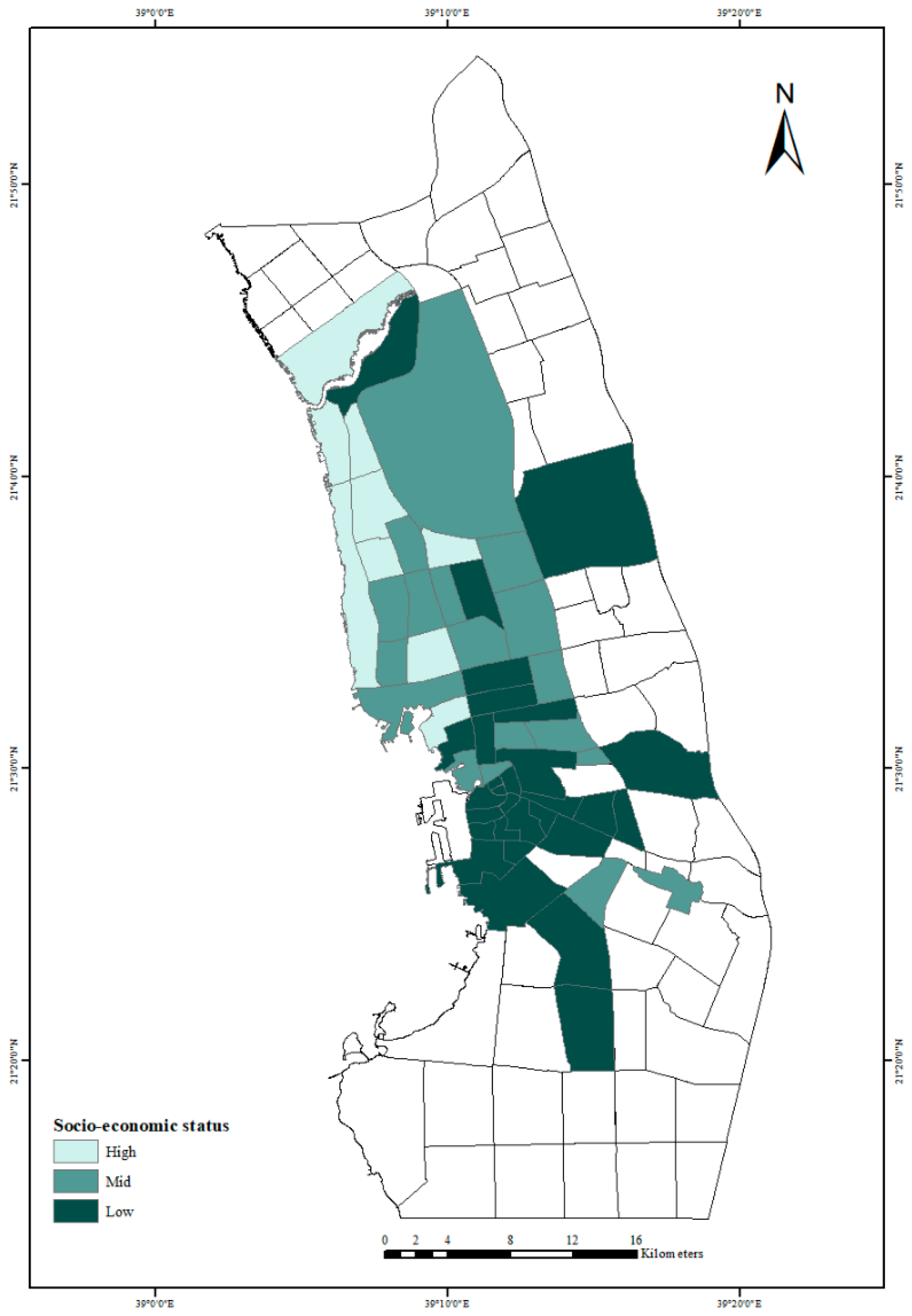
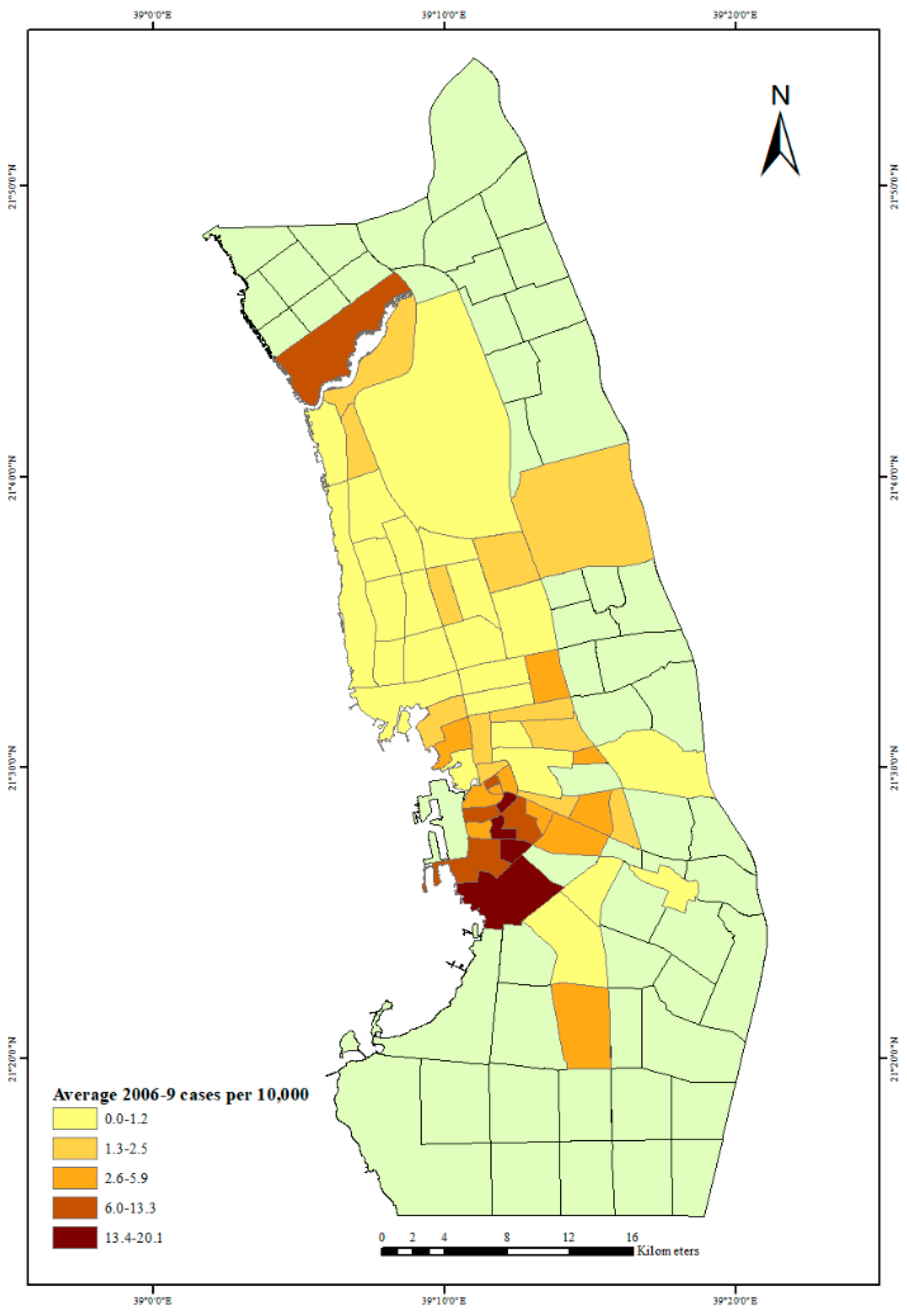
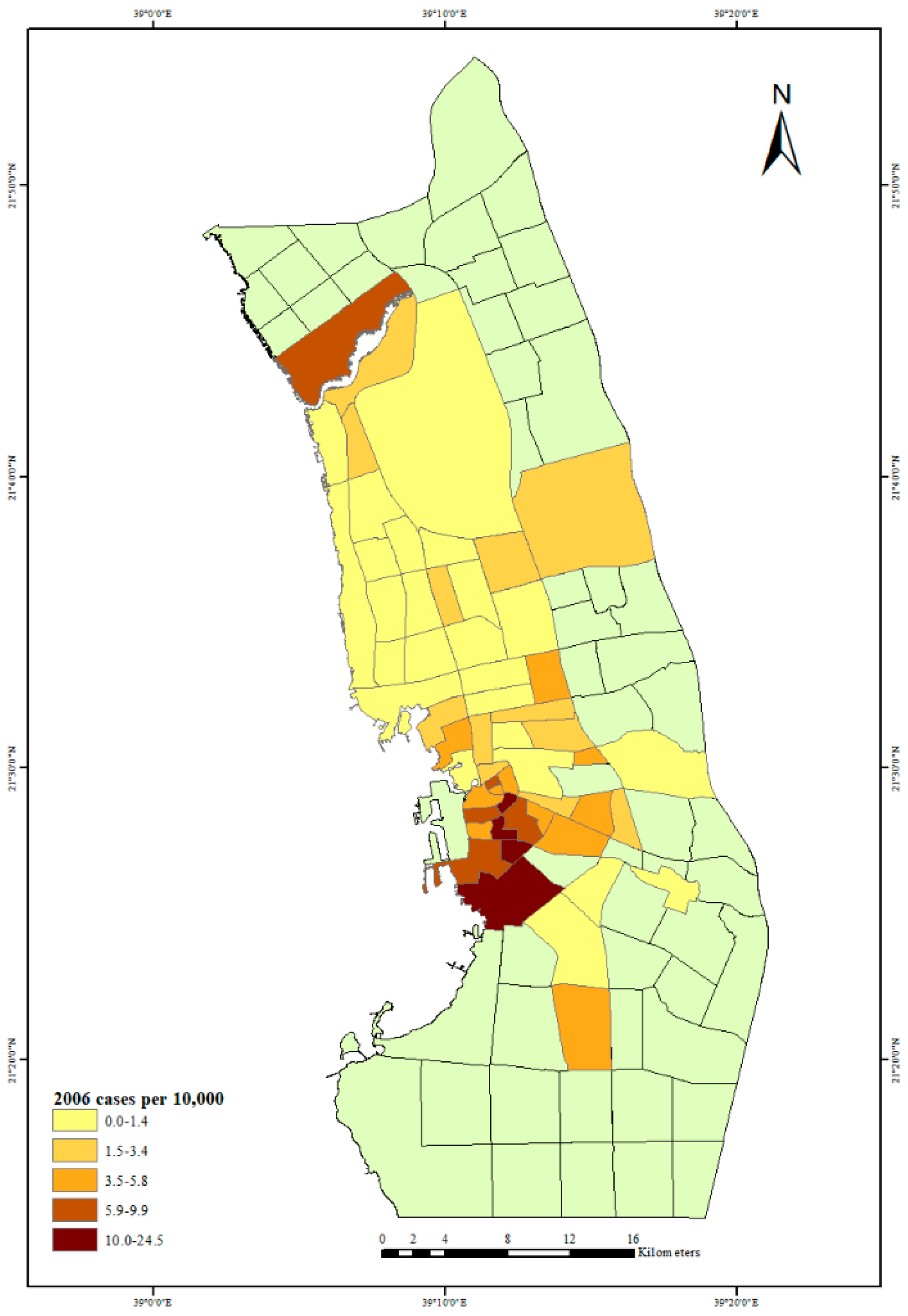

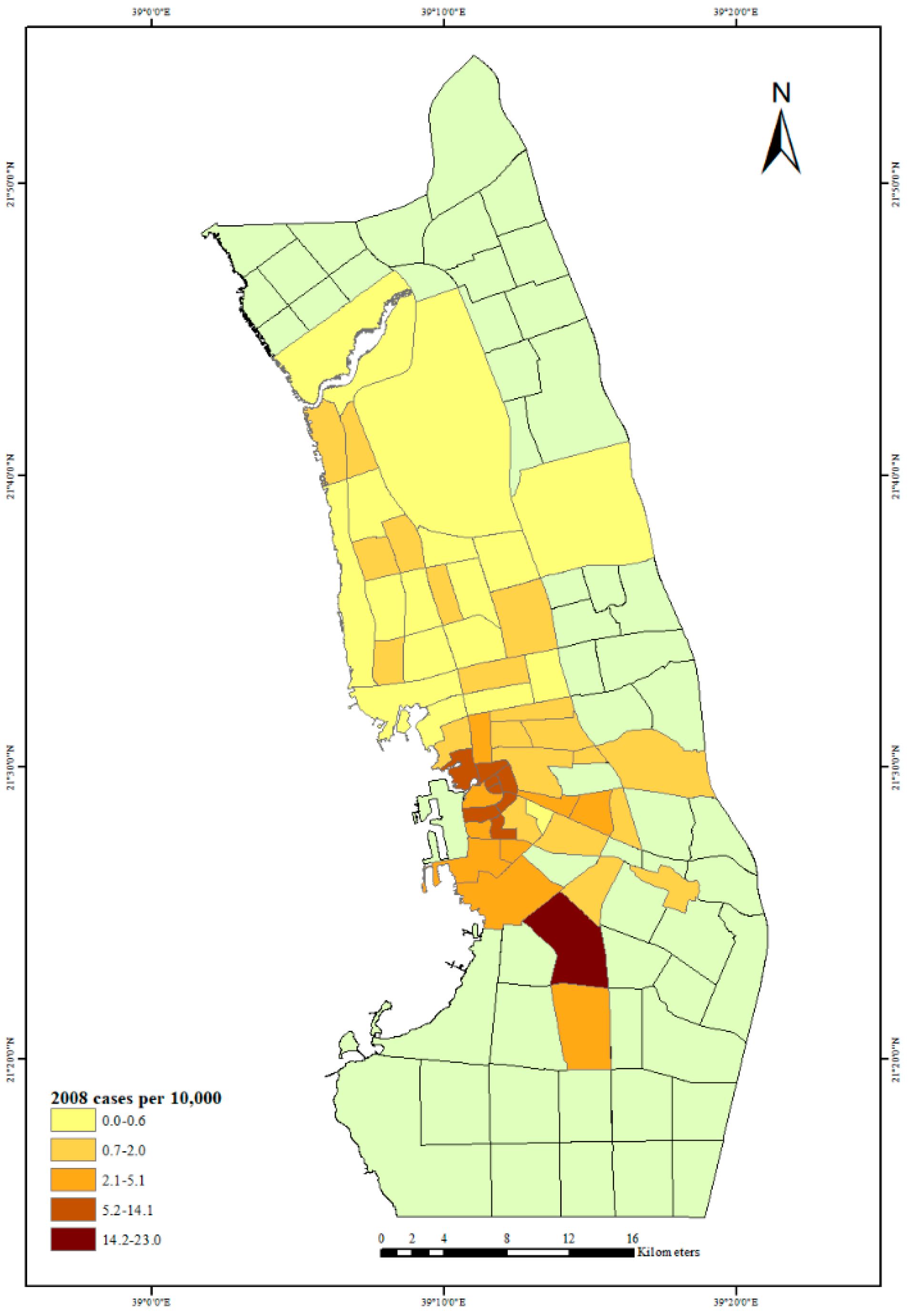
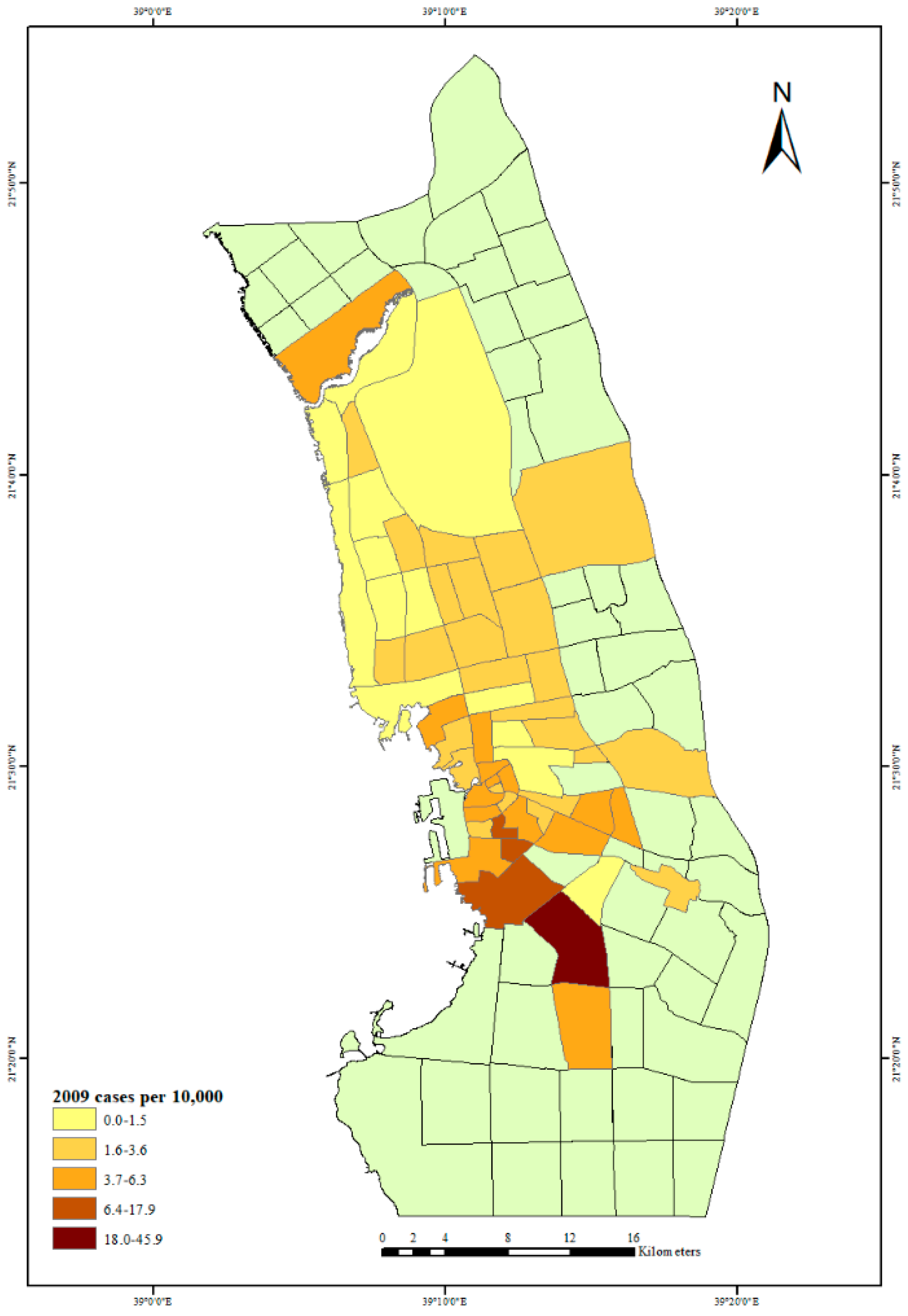
| Year | Mean | Standard Deviation | ||||
|---|---|---|---|---|---|---|
| High SES | Mid SES | Low SES | High SES | Mid SES | Low SES | |
| Cases, 2006 | 11.2 | 7.0 | 27.2 | 16.8 | 7.3 | 30.8 |
| Cases, 2007 | 1.1 | 2.00 | 4.0 | 0.8 | 3.1 | 4.5 |
| Cases, 2008 | 1.6 | 5.8 | 17.8 | 1.4 | 7.3 | 16.4 |
| Cases, 2009 | 5.4 | 11.7 | 27.3 | 5.9 | 15.1 | 23.8 |
| Average Cases, 2006–2009 | 4.8 | 6.6 | 19.1 | 5.2 | 6.9 | 15.3 |
| Rate cases, 2006 | 6.2 | 2.4 | 6.5 | 11.5 | 3.2 | 7.5 |
| Rate cases, 2007 | 0.7 | 0.3 | 1.2 | 0.9 | 0.4 | 2.4 |
| Rate cases, 2008 | 0.5 | 1.9 | 4.7 | 0.4 | 3.6 | 5.3 |
| Rate cases, 2009 | 6.0 | 3.1 | 6.7 | 8.3 | 7.1 | 9.2 |
| Average rate cases, 2006–2009 | 3.4 | 1.9 | 4.8 | 4.7 | 3.9 | 4.5 |
Publisher’s Note: MDPI stays neutral with regard to jurisdictional claims in published maps and institutional affiliations. |
© 2021 by the authors. Licensee MDPI, Basel, Switzerland. This article is an open access article distributed under the terms and conditions of the Creative Commons Attribution (CC BY) license (https://creativecommons.org/licenses/by/4.0/).
Share and Cite
Alkhaldy, I.; Barnett, P. Evaluation of Neighborhood Socio-Economic Status, as Measured by the Delphi Method, on Dengue Fever Distribution in Jeddah City, Saudi Arabia. Int. J. Environ. Res. Public Health 2021, 18, 6407. https://doi.org/10.3390/ijerph18126407
Alkhaldy I, Barnett P. Evaluation of Neighborhood Socio-Economic Status, as Measured by the Delphi Method, on Dengue Fever Distribution in Jeddah City, Saudi Arabia. International Journal of Environmental Research and Public Health. 2021; 18(12):6407. https://doi.org/10.3390/ijerph18126407
Chicago/Turabian StyleAlkhaldy, Ibrahim, and Pauline Barnett. 2021. "Evaluation of Neighborhood Socio-Economic Status, as Measured by the Delphi Method, on Dengue Fever Distribution in Jeddah City, Saudi Arabia" International Journal of Environmental Research and Public Health 18, no. 12: 6407. https://doi.org/10.3390/ijerph18126407
APA StyleAlkhaldy, I., & Barnett, P. (2021). Evaluation of Neighborhood Socio-Economic Status, as Measured by the Delphi Method, on Dengue Fever Distribution in Jeddah City, Saudi Arabia. International Journal of Environmental Research and Public Health, 18(12), 6407. https://doi.org/10.3390/ijerph18126407





